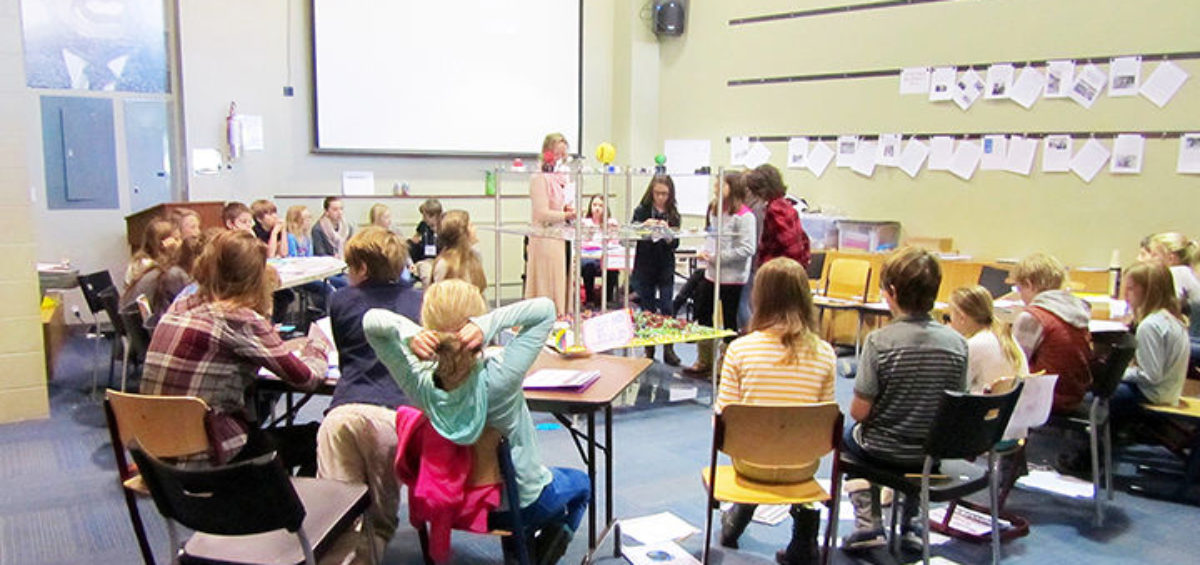World Peace Game engages students at Telluride Mountain School
By Amy M. Peters, Planet Contributor Dec 1, 2016
This week, students in fifth through eighth grades at Telluride Mountain School spent 15 hours over four days at school participating in the World Peace Game, a hands-on political simulation that enables students to explore world connectedness through the lens of economic, social and environmental crises, and the imminent threat of war.
The game was founded by elementary school teacher John Hunter in 1978, who played it with his own fourth-grade class. Since a documentary was created about the game, Hunter has traveled the world training and accrediting official facilitators.
“This is his work. And his gem,” explained Jackie Burt, one of two facilitators from the World Peace Game Foundation who spent the week facilitating the game for TMS students. “And we do our best to uphold his values to create this experience for kids as far and wide as we can.”
Burt said the game involves 24 crises that interlock in 50 different ways across four fictional countries represented by “nation teams” where students each have a role — as prime ministers, CFOs of countries, president of the World Bank — to help “make the world work.” The game opens with each of the countries in conflict and pitted against one another. In the course of the game, countries must be extricated from dangerous circumstances and need to achieve global prosperity with the least amount of military intervention.
“The objective of the game,” Burt said, “is to solve every crisis thereby creating world peace as well as increasing the net worth or asset value of each country.”
He said it’s all meant to empower students to know who they are as leaders, collaborators and problem-solvers through interaction and thinking.
Head of School Karen Walker has been interested in the game for five years.
“When we began expanding the global aspect of our curriculum, two parents suggested we pursue the World Peace Game,” she said. “And we looked at it and wanted to do it but it was expensive.”
Stephanie Griebe, advancement director at the school, said an anonymous donor from outside of the school community generously underwrote the program.
“When (the World Peace Game Foundation) reached out to us, we jumped at the opportunity!” Griebe said. “And we would love to have the opportunity to host the games again for another group of students.”
On Wednesday morning, students addressed a refugee crisis with one country refusing to receive refugees while other countries were in negotiations for developing refugee housing. There was an oil spill and a satellite was about to crash into another satellite. A burial ground was lodged underneath a sought-after source of gold while in a separate conflict endangered species dwelled beneath a source of diamonds.
In the mix is a “saboteur,” whose job it is to insert uncertainty and secret conflict.
“Every student in the room is wondering who that saboteur is,” Burt said. The saboteur was not expected to be revealed until Friday.
“I’m finding this to be really educational and enjoyable,” student Tessa Boukouvis said. “I’ve learned what all the different departments do and how to develop a treaty and how to solve crises in the most creative ways.”
Fifth-graders Siri Shoff and Grace Lynch agreed.
“I’ve learned that a lot of countries are against each other and they can work together but it can be really hard because they have uneven amounts of money and supplies,” Shoff said.
“You have to think about more than just wars happening,” Lynch added. “You have to think about the environment, your community and the future.”
Currently, TMS fifth- and sixth-graders are studying ancient Rome. Their teacher, Jacqui Power, feels the game will jibe well with the curriculum because students need to understand how to run a society.
“They are going to return to the classroom on Monday with a depth of knowledge about government and how complex the world is,” Power said. “It’s been pretty incredible to see all the information they are absorbing through experience. That’s what we do at TMS — experiential learning — learning by doing.”





Leave a Comment